Canyonville Oregon Show
By Scott Morrell
Reprinted from "Crown Jewels of the Wire", February 2004, page 37
November's Jefferson State Insulator and Bottle Show can be summed up in one
word: SUCCESS! We had 90 sales tables, approximately half bottles and half
insulators. The Seven Feathers convention hall was plush, and the casino's
service was great. The dealers were impressed with the show hall, praised the
lighting and spaciousness, and were generally pleased with the entire event.
What's more, the show was a financial success. Dealer reservations and raffle
proceeds covered all expenses and returned a tidy profit for the insulator
club... seed money for our next show this fall.
One of the features of the show
was a silent auction of goodies brought in by the public. We weren't sure how
many walk-ins would attend, but our uncertainty turned to astonishment as an
endless onslaught of people arrived with items to appraise and sell. At times,
there were lines of people waiting with boxes and sacks full of insulators and
bottles.
Items that 'walked in" included CALIFORNIA helmets in sage and
yellow, an amber CD 162, lots of black glass MCLAUGHLIN tolls, a box full of
purple Whitall Tatums, a big purple AGEE, plus loads of porcelain. One lady had
a cardboard box full of glass and porcelain radio strains in a rainbow of
colors. The strains struck the fancy of Barb Smith, whose winning bid allowed
her to take the whole box home. Many good bottles walked in as well, but I won't
bore you insulators collectors with those.
Insulator displays included Carl
Scott's porcelain johnny balls & CALIFORNIA insulators; a new porcelain discovery by Barb Smith & Carver Mead; Gil Hedges cobalt porcelain; Gary
Michener's CD 120's, and Mindy Michener's CD 102 ponies.
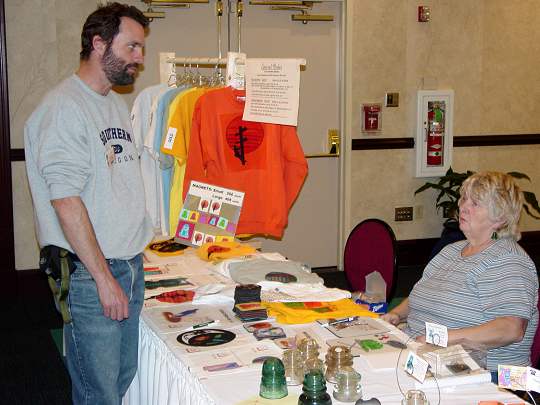
Scott Morrell considers ordering an insulator shirt from Mary Ann Thomas.
Among the outstanding insulators that changed hands at the Canyonville show
were the three CD 123 EC&M's shown on the next page. Vi Brown brought the
bright green and cobalt blue examples. The bright green EC&M is a B mold
(smaller upper loop on the ampersand, straight skirt, and button on the
reverse). The cobalt is an F mold (extended skirt, flared skirt, button on
reverse). Both now reside in the collection of Tim Wood.
Scott Morrell sold the
apple green EC&M at the bottom of the page. It's a G mold (extended skirt,
straight skirt, button on reverse). Scott purchased this insulator at a garage
sale in Ashland, Oregon a couple of years ago from a woman who had collected
back in the 1960's. Her next best insulator on the day of the garage sale was a
CD 154 purple Whitall Tatum. Scott sold this insulator in a silent auction at
the Canyonville show, with Frank Feher the winning bidder.
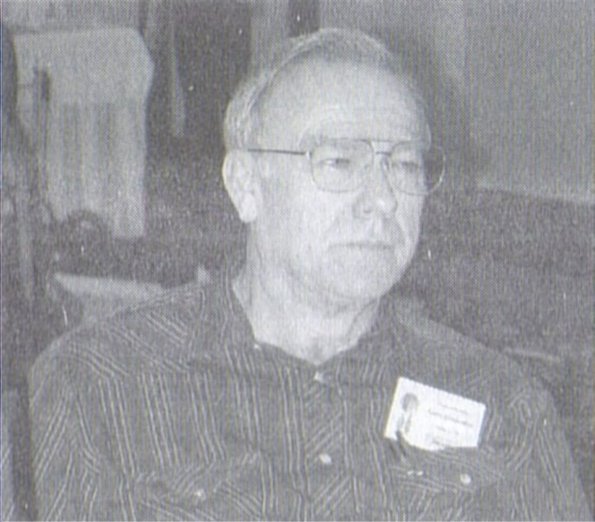
Larry Shumaker enjoys the show from his sales table.
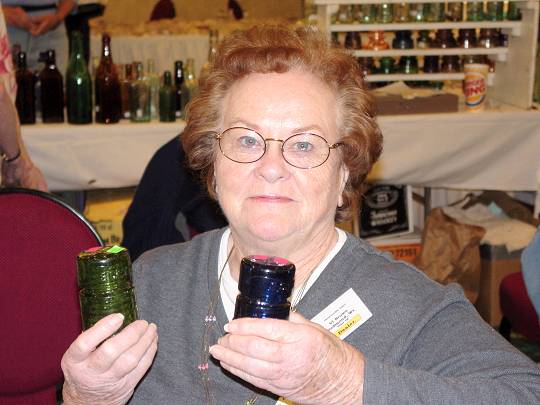
Vi Brown tempts the editor with two colorful EC&M's.
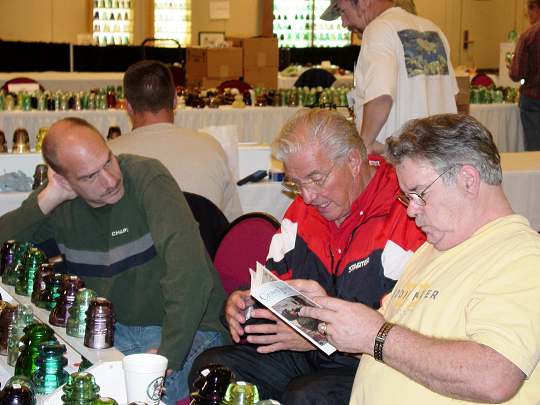
Steve
Nickoloff, Don Berke & Chuck Irwin check out
the latest issue of Crown
Jewels of the Wire.
CANYONVILLE SHOW HIGHLIGHTS
These three CD 123 EC&M's were among the western insulators that
exchanged hands at the Canyonville Show.
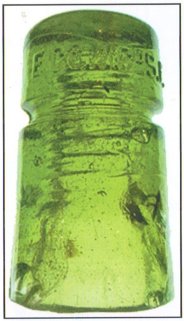
B-mold EC&M in a bright green
that borders on chartreuse.
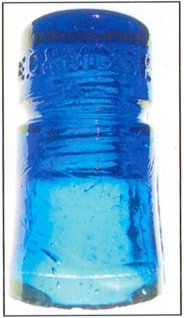
F-mold, flared skirt, EC&M
in bright cobalt.
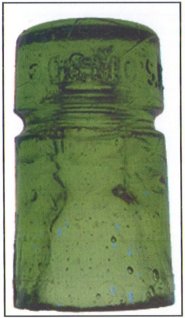
G-Mold EC&M in apple green.
This one surfaced in a garage sale a
couple years ago in Ashland, OR.
CANYONVILLE'S MAGNIFICENT MULTI'S
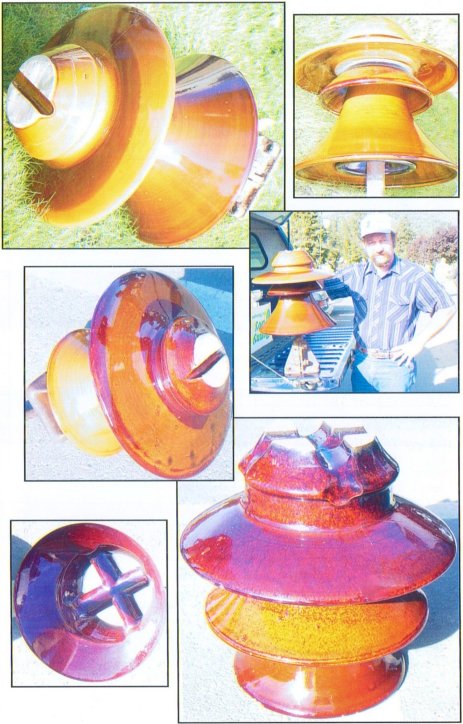
MUD found its way to Canyonville, too. Some of the porcelain insulators
created quite a stir. They seemed to have everything going for them: extremely rare styles, large sized multiparts, and great glazes. .
Mike Spadafora writes about them...
"Two examples of the Thomas M-4710 (top pictures on page 40) were
recovered by Ron Yuhas from the yard of a long retired lineman in central
Montana. The lineman, now deceased, retired more than thirty years ago from
Montana Power. As best as Ron could determine, the man had the insulators for
more than fifty years as yard decorations. Both specimens appear to have been
installed in a substation, and were not used a regular line insulators. From my
own personal research, I suspect they were once used in either the Great Falls
or Butte substations on what was essentially a suspension line."
In the inset picture, compare the size of the insulator to Bill Rohde, who
steadied it on his tailgate for Crown Jewels to take a photograph. (With the
pins still cemented into some of these giant insulators, they wouldn't be
stable enough to stand upright on their own for picture taking.)
Regarding the insulator in the middle, Mike writes, "The M-2996 Thomas
is believed to only have been used in two locations. One was on a transmission
line from the Tacoma powerhouse to Silverton, CO. The other was indoors to
support the bus work in the Madison River powerhouse in Montana. I recovered two
specimens from the Colorado line, and eight from the Montana plant.
Interestingly, all the original lines in the area of the Madison plant only used
glass Muncie's or #1 Provo's."
Catching a lot of "oohs" and" ahhs" was the porcelain
cross top shown in the bottom two pictures on page 40. Mike fills us in on the
discovery, "The M-4338 Victor cross tops, marked with the R=00 insulator
logo, were found in a dump behind the Tacoma power house near Durango, Colorado.
One mint original and several damaged specimens were recovered from a total of
nineteen insulators that were originally used in the plant substation.
"The insulators were installed as part of a pair of three phase
disconnect switches. Three insulators were used for each phase. The center
insulator had the switch blade mounted on its crown, and had a special pin with
brass bushings which allowed the switch insulator to rotate ninety degrees thus
opening the switch. No surviving complete examples of this switch assembly are
known to exist.'
The Canyonville show replaces insulator and bottles shows previously held in
Medford, Oregon. Canyonville will play host again to more great porcelain and
glass in mid-October.
| 